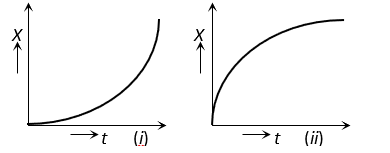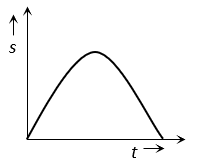Physics-
General
Easy
Question
Two balls are dropped to the ground from different heights. One ball is dropped  after the other but they both strike the ground at the same time. If the first ball takes
after the other but they both strike the ground at the same time. If the first ball takes  to reach the ground, then the difference in initial heights is
to reach the ground, then the difference in initial heights is 
The correct answer is: 
Related Questions to study
Physics-
A lift in which a man is standing, is moving upward with a speed of 10 The man drops a coin from a height of 4.9m and if
The man drops a coin from a height of 4.9m and if  then the coin reaches the floor of the lift after a time
then the coin reaches the floor of the lift after a time
A lift in which a man is standing, is moving upward with a speed of 10 The man drops a coin from a height of 4.9m and if
The man drops a coin from a height of 4.9m and if  then the coin reaches the floor of the lift after a time
then the coin reaches the floor of the lift after a time
Physics-General
Physics-
Consider the acceleration, velocity and displacement of a tennis ball as it falls to the ground and bounces back. Directions of which of these changes in the process
Consider the acceleration, velocity and displacement of a tennis ball as it falls to the ground and bounces back. Directions of which of these changes in the process
Physics-General
Physics-
Figures i) and ii) below show the displacement-time graphs of two particles moving along the  -axis. We can say that
-axis. We can say that
Figures i) and ii) below show the displacement-time graphs of two particles moving along the  -axis. We can say that
-axis. We can say that Physics-General
Physics-General
Physics-General
Physics-
The graph of displacement  time is
time is
Its corresponding velocity-time graph will be
The graph of displacement  time is
time is
Its corresponding velocity-time graph will be
Physics-General
Physics-
A cat moves from  to
to  with a uniform speed
with a uniform speed  and returns toX with a uniform speed
and returns toX with a uniform speed  . The average speed for this ground trip is
. The average speed for this ground trip is
A cat moves from  to
to  with a uniform speed
with a uniform speed  and returns toX with a uniform speed
and returns toX with a uniform speed  . The average speed for this ground trip is
. The average speed for this ground trip is
Physics-General
Physics-
A student is standing at a distance of 50 m from the bus. As soon as the bus begins its motion with an acceleration of  the students starts running towards the bus with a uniform velocity
the students starts running towards the bus with a uniform velocity  Assuming the motion to be along a straight road, the minimum value of
Assuming the motion to be along a straight road, the minimum value of  so that the student is able to catch the bus is
so that the student is able to catch the bus is
A student is standing at a distance of 50 m from the bus. As soon as the bus begins its motion with an acceleration of  the students starts running towards the bus with a uniform velocity
the students starts running towards the bus with a uniform velocity  Assuming the motion to be along a straight road, the minimum value of
Assuming the motion to be along a straight road, the minimum value of  so that the student is able to catch the bus is
so that the student is able to catch the bus is
Physics-General
Physics-
The numerical ratio of displacement to the distance covered is always
The numerical ratio of displacement to the distance covered is always
Physics-General
Physics-
Two trains travelling on the same track are approaching each other with equal speeds of 40 . The drivers of the trains begin to decelerate simultaneously when they are just
. The drivers of the trains begin to decelerate simultaneously when they are just  apart. Assuming the decelerations to be uniform and equal, the value of the deceleration to barely avoid collision should be
apart. Assuming the decelerations to be uniform and equal, the value of the deceleration to barely avoid collision should be
Two trains travelling on the same track are approaching each other with equal speeds of 40 . The drivers of the trains begin to decelerate simultaneously when they are just
. The drivers of the trains begin to decelerate simultaneously when they are just  apart. Assuming the decelerations to be uniform and equal, the value of the deceleration to barely avoid collision should be
apart. Assuming the decelerations to be uniform and equal, the value of the deceleration to barely avoid collision should be
Physics-General
Physics-
A body freely falling from the rest has a velocity  after it falls through a height ‘
after it falls through a height ‘ .
.
The distance it has to fall down for its velocity to become double, is
A body freely falling from the rest has a velocity  after it falls through a height ‘
after it falls through a height ‘ .
.
The distance it has to fall down for its velocity to become double, is
Physics-General
Physics-
A truck and a car are moving with equal velocity. On applying the brakes both will stop after certain distance, then
A truck and a car are moving with equal velocity. On applying the brakes both will stop after certain distance, then
Physics-General
Physics-
A body starts from origin and moves along  -axis such that at any instant velocity is
-axis such that at any instant velocity is  where
where  is in second and
is in second and  in
in  . The acceleration of the particle when it is 2m from the origin is
. The acceleration of the particle when it is 2m from the origin is
A body starts from origin and moves along  -axis such that at any instant velocity is
-axis such that at any instant velocity is  where
where  is in second and
is in second and  in
in  . The acceleration of the particle when it is 2m from the origin is
. The acceleration of the particle when it is 2m from the origin is
Physics-General
Physics-
Two balls are dropped to the ground from different heights. One ball is dropped 2 s after the other but they both strike the ground at the same time. If the first ball takes 5 s to reach the ground, then the difference in initial heights is 
Two balls are dropped to the ground from different heights. One ball is dropped 2 s after the other but they both strike the ground at the same time. If the first ball takes 5 s to reach the ground, then the difference in initial heights is 
Physics-General
Physics-
A particle is projected with velocity  along
along  The deceleration on the particle is proportional to the square of the distance from the origin i.e.,
The deceleration on the particle is proportional to the square of the distance from the origin i.e.,  The distance at which the particle stops is
The distance at which the particle stops is
A particle is projected with velocity  along
along  The deceleration on the particle is proportional to the square of the distance from the origin i.e.,
The deceleration on the particle is proportional to the square of the distance from the origin i.e.,  The distance at which the particle stops is
The distance at which the particle stops is
Physics-General
Physics-
A person travels along a straight road for the first half time with a velocity  and the next half time with a velocity
and the next half time with a velocity 
The mean velocity  of the man is
of the man is
A person travels along a straight road for the first half time with a velocity  and the next half time with a velocity
and the next half time with a velocity 
The mean velocity  of the man is
of the man is
Physics-General
Physics-
A boat takes two hours to travel 8 km and back in still water. If the velocity of water 4  , the time taken for going ups tream 8km and coming back is
, the time taken for going ups tream 8km and coming back is
A boat takes two hours to travel 8 km and back in still water. If the velocity of water 4  , the time taken for going ups tream 8km and coming back is
, the time taken for going ups tream 8km and coming back is
Physics-General



